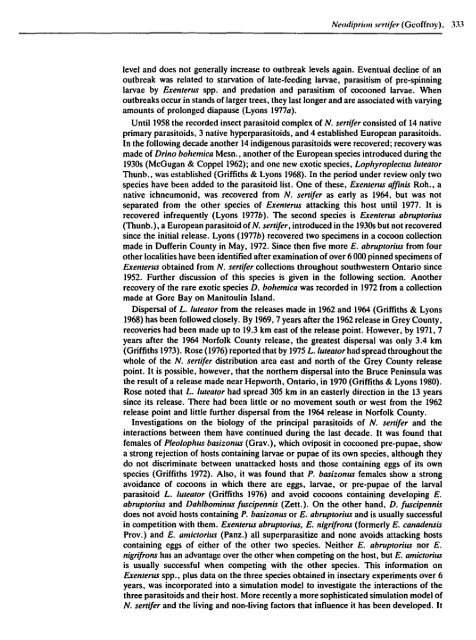pdf, 57.71Mb - Entomological Society of Canada
pdf, 57.71Mb - Entomological Society of Canada
pdf, 57.71Mb - Entomological Society of Canada
You also want an ePaper? Increase the reach of your titles
YUMPU automatically turns print PDFs into web optimized ePapers that Google loves.
Neot!i/Jrio" satifer (Ge<strong>of</strong>froy), 333<br />
level and does not generally increase to outbreak levels again. Eventual decline <strong>of</strong> an<br />
outbreak was related to starvation <strong>of</strong> late-feeding larvae, parasitism <strong>of</strong> pre-spinning<br />
larvae by Exenlerus spp. and predation and parasitism <strong>of</strong> cocooned larvae. When<br />
outbreaks occur in stands <strong>of</strong> larger trees, they last longer and are associated with varying<br />
amounts <strong>of</strong> prolonged diapause (Lyons 1977a).<br />
Until 1958 the recorded insect parasitoid complex <strong>of</strong> N. sertifer consisted <strong>of</strong> 14 native<br />
primary parasitoids, 3 native hyperparasitoids, and 4 established European parasitoids.<br />
In the following decade another 14 indigenous parasitoids were recovered; recovery was<br />
made <strong>of</strong> Drino bolremica Mesn., another <strong>of</strong> the European species introduced during the<br />
1930s (McGugan & CoppeI1962); and one new exotic species, Lophyroplectus lutealor<br />
Thunb., was established (Griffiths & Lyons 1968). In the period under review only two<br />
species have been added to the parasitoid list. One <strong>of</strong> these, Exenterus affinis Roh., a<br />
native ichneumonid, was recovered from N. sertifer as early as 1964, but was not<br />
separated from the other species <strong>of</strong> Exenlerus attacking this host until 1977. It is<br />
recovered infrequently (Lyons 1977b). The second species is Exenterus abruptorius<br />
(Thunb.), a European parasitoid <strong>of</strong> N. sertifer, introduced in the 1930s but not recovered<br />
since the initial release. Lyons (1977b) recovered two specimens in a cocoon collection<br />
made in Dufferin County in May, 1972. Since then five more E. abruptorius from four<br />
other localities have been identified after examination <strong>of</strong> over 6 000 pinned specimens <strong>of</strong><br />
Exenterus obtained from N. ser/ifer collections throughout southwestern Ontario since<br />
1952. Further discussion <strong>of</strong> this species is given in the following section. Another<br />
recovery <strong>of</strong> the rare exotic species D. bohemiea was recorded in 1972 from a collection<br />
made at Gore Bay on Manitoulin Island.<br />
Dispersal <strong>of</strong> L. IUleator from the releases made in 1962 and 1964 (Griffiths & Lyons<br />
1968) has been followed closely. By 1969,7 years afterthe 1962 release in Grey County,<br />
recoveries had been made up to 19.3 km east <strong>of</strong> the release point. However, by 1971, 7<br />
years after the 1964 Norfolk County release, the greatest dispersal was only 3.4 km<br />
(Griffiths 1973). Rose (1976) reported that by 1975 L.luteatorhad spread throughout the<br />
whole <strong>of</strong> the N. sertifer distribution area east and north <strong>of</strong> the Grey County release<br />
point. It is possible, however, that the northern dispersal into the Bruce Peninsula was<br />
the result <strong>of</strong> a release made near Hepworth, Ontario, in 1970 (Griffiths & Lyons 1980).<br />
Rose noted that L. luteator had spread 305 km in an easterly direction in the 13 years<br />
since its release. There had been little or no movement south or west from the 1962<br />
release point and little further dispersal from the 1964 release in Norfolk County.<br />
Investigations on the biology <strong>of</strong> the principal parasitoids <strong>of</strong> N. sertifer and the<br />
interactions between them have continued during the last decade. It was found that<br />
females <strong>of</strong> Pleolophus basizonus (Grav.), which oviposit in cocooned pre-pupae, show<br />
a strong rejection <strong>of</strong> hosts containing larvae or pupae <strong>of</strong> its own species, although they<br />
do not discriminate between unattacked hosts and those containing eggs <strong>of</strong> its own<br />
species (Griffiths 1972). Also, it was found that P. basizonus females show a strong<br />
avoidance <strong>of</strong> cocoons in which there are eggs, larvae, or pre-pupae <strong>of</strong> the larval<br />
parasitoid L. lutealor (Griffiths 1976) and avoid cocoons containing developing E.<br />
abruptorius and Dahlbominus fuscipennis (Zelt.). On the other hand, D. fuscipennis<br />
does not avoid hosts containing P. basizonus or E. abruptorius and is usually successful<br />
in competition with them. Exenterus abruptorius, E. nigrifrons (formerly E. canadensis<br />
Prov.) and E. amielorius (Panz.) all superparasitize and none avoids attacking hosts<br />
containing eggs <strong>of</strong> either <strong>of</strong> the other two species. Neither E. abruptorius nor E.<br />
nigrifrons has an advantage over the other when competing on the host, but E. amictorius<br />
is usually successful when competing with the other species. This information on<br />
Exenterus spp .• plus data on the three species obtained in insectary experiments over 6<br />
years, was incorporated into a simulation model to investigate the interactions <strong>of</strong> the<br />
three parasitoids and their host. More recently a more sophisticated simulation model <strong>of</strong><br />
N. sertifer and the living and non-living factors that influence it has been developed. It
















